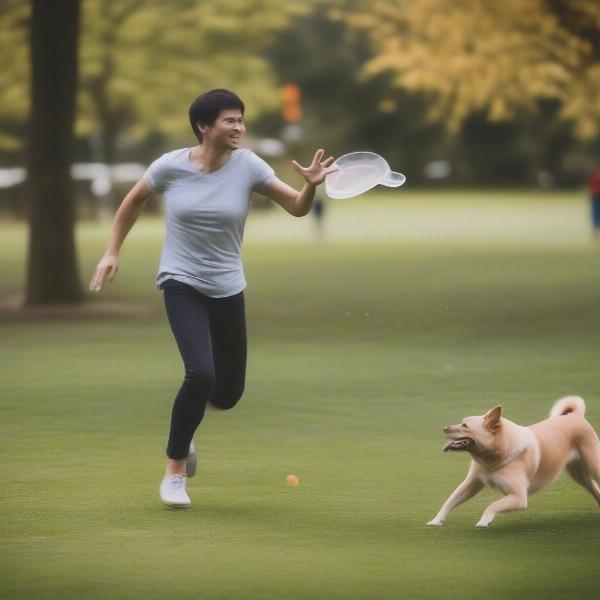Flying disk dog toys, also known as frisbees, are a classic choice for interactive play with your canine companion. They offer a fantastic way to bond with your dog while providing both physical and mental stimulation. Choosing the right flying disk and understanding safe playing techniques will ensure hours of fun and contribute to a healthy, happy dog.
Choosing the Right Flying Disk for Your Dog
Not all flying disks are created equal, and selecting the appropriate one for your dog depends on factors like size, age, and chewing habits.
- Size: For smaller dogs or puppies, choose a smaller, softer flying disk. Larger dogs will benefit from standard-sized or even larger disks designed for more extended throws.
- Material: Soft, flexible materials are ideal for puppies and gentle chewers, reducing the risk of dental injuries. Durable rubber or plastic disks are better suited for enthusiastic chewers. Avoid hard plastic disks, as these can damage your dog’s teeth.
- Durability: If your dog is a powerful chewer, invest in a heavy-duty flying disk specifically designed to withstand vigorous chewing.
Safe Playing Techniques with Flying Disks
While flying disk play can be incredibly rewarding, it’s crucial to prioritize your dog’s safety.
- Warm-up: Just like humans, dogs need a proper warm-up before engaging in strenuous activity. A brisk walk or light jog will help prepare their muscles for the activity.
- Flat Throws: Avoid throwing the disk vertically or at high angles, as this can lead to awkward jumps and potential injuries. Aim for low, flat throws.
- Soft Landings: Choose a grassy or sandy surface for playing, avoiding concrete or asphalt, which can be hard on your dog’s joints upon landing.
- Hydration: Always have fresh water available for your dog, especially during hot weather. Frequent breaks for water are essential.
- Know Your Dog’s Limits: Pay attention to your dog’s body language. If they seem tired or are showing signs of overheating, stop the game and allow them to rest.
 Safe flying disc playing techniques
Safe flying disc playing techniques
The Benefits of Flying Disk Play
Beyond the sheer joy of watching your dog chase and catch a flying disk, this activity offers several significant benefits:
- Physical Exercise: Flying disk provides excellent cardiovascular exercise, strengthening muscles and improving overall fitness.
- Mental Stimulation: The challenge of tracking and catching the disk engages your dog’s mind, preventing boredom and promoting mental agility.
- Bonding: This interactive game strengthens the bond between you and your dog, fostering trust and companionship.
Introducing Your Dog to Flying Disks
If your dog is new to flying disks, start slowly and make it a positive experience.
- Introduce the Disk: Let your dog sniff and explore the disk, rewarding them with treats and praise.
- Short Tosses: Begin with short rolls or tosses on the ground, encouraging your dog to chase and retrieve.
- Gradually Increase Distance: As your dog becomes more comfortable, gradually increase the distance of your throws.
- Positive Reinforcement: Use positive reinforcement techniques, such as praise, treats, and enthusiastic encouragement, to keep your dog motivated and engaged.
Conclusion
Flying disk dog toys are a fantastic way to enhance your dog’s physical and mental well-being while strengthening your bond. Choosing the right disk, using safe playing techniques, and introducing the activity gradually will ensure a positive and rewarding experience for both you and your furry friend.
FAQ
- What if my dog doesn’t seem interested in the flying disk? Try using a different type of disk or making the game more enticing with treats or a favorite toy.
- Can puppies play with flying disks? Yes, but choose soft, flexible disks and avoid excessive jumping or throwing until they are fully grown.
- What if my dog chews the flying disk? Supervise play and choose durable disks designed for chewers. Replace damaged disks promptly to prevent ingestion of small pieces.
- How often can I play flying disk with my dog? Start with short sessions and gradually increase the duration and frequency as your dog’s fitness improves.
- Is flying disk play suitable for all breeds? Most breeds can enjoy flying disk, but consult with your veterinarian if you have concerns about your dog’s breed or health condition.
- What are some alternative toys for fetch if my dog doesn’t like flying discs? Balls, ropes, and plush toys are all great alternatives for fetch.
- Where can I purchase high-quality flying discs for dogs? Pet stores, online retailers, and specialty dog stores offer a wide selection of flying discs.
ILM Dog is your trusted source for expert advice on all aspects of dog care and training. We offer a comprehensive range of resources, from breed selection and healthcare to nutrition and behavior. From puppyhood to senior years, we’re here to help you provide the best possible care for your canine companion. For expert guidance, contact us at [email protected] or +44 20-3965-8624. Visit ILM Dog for more information on dog health, nutrition, and training.